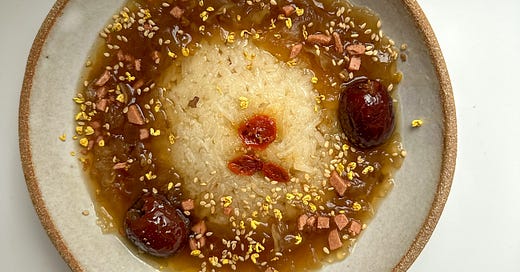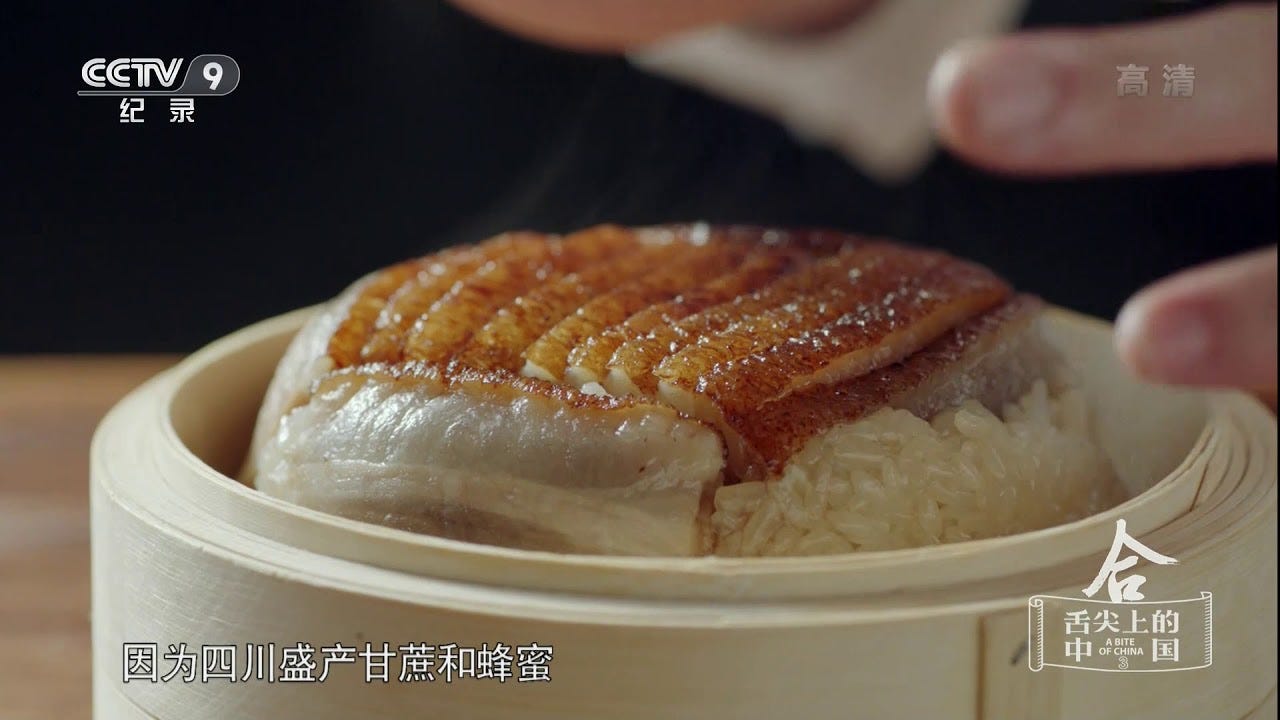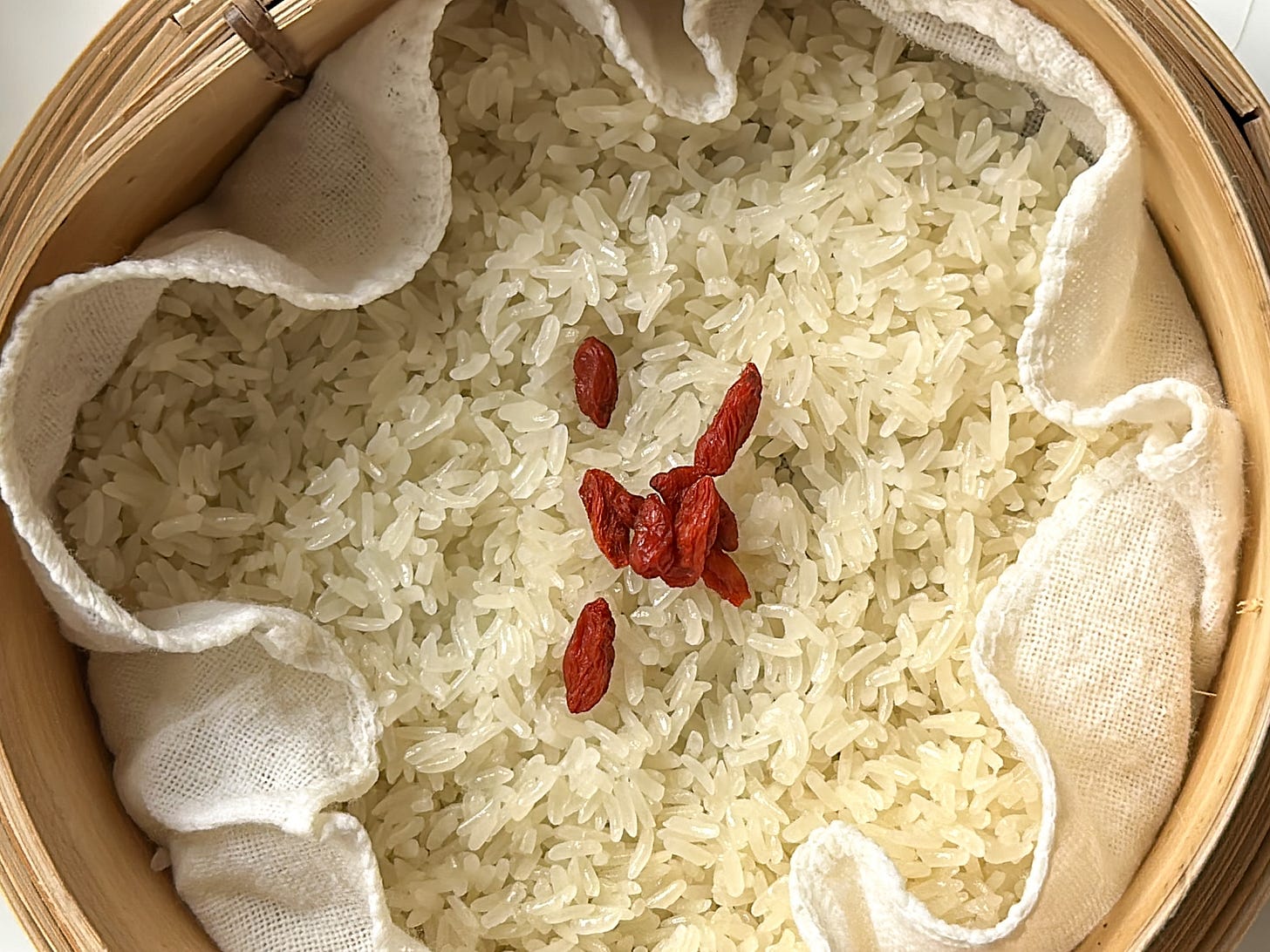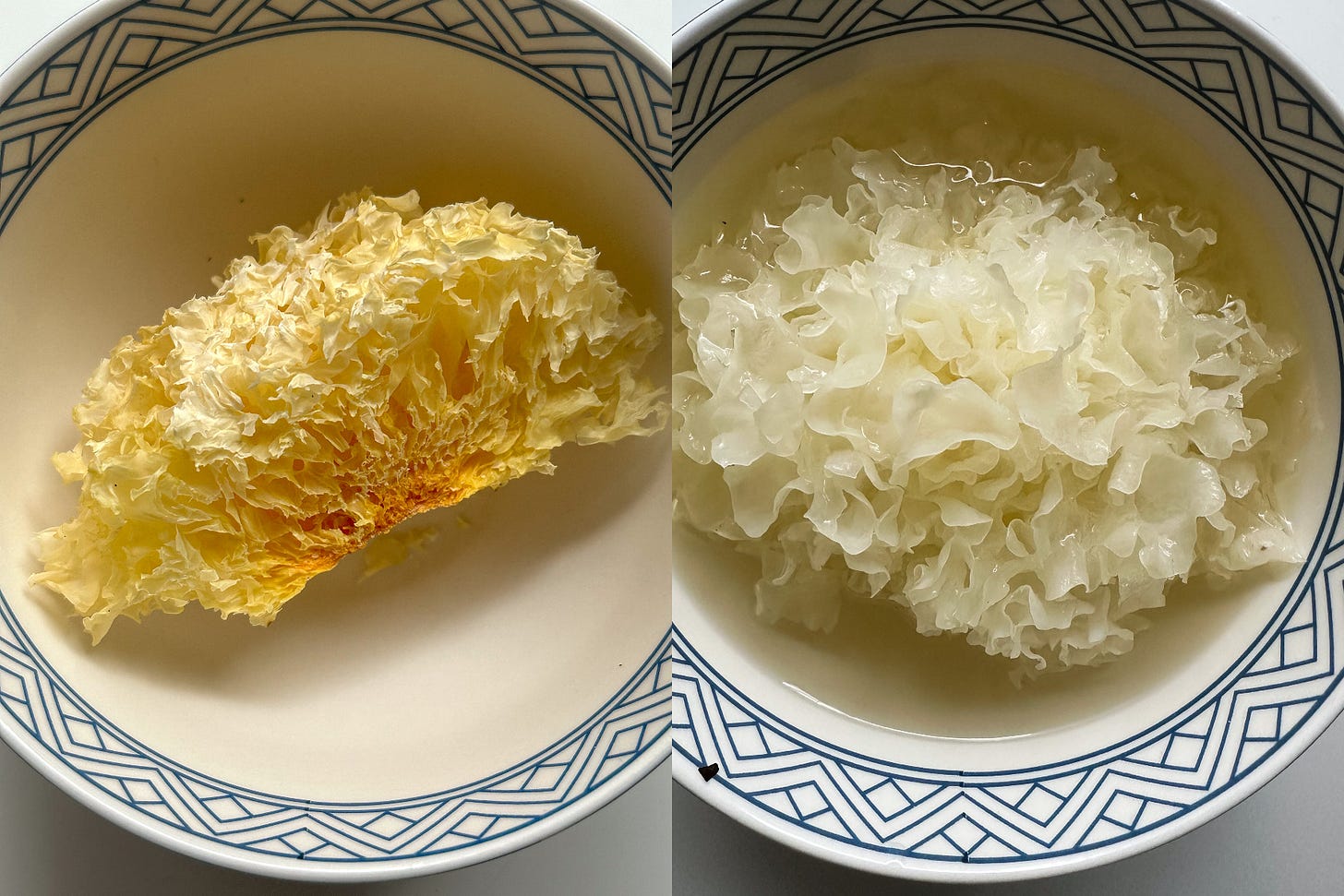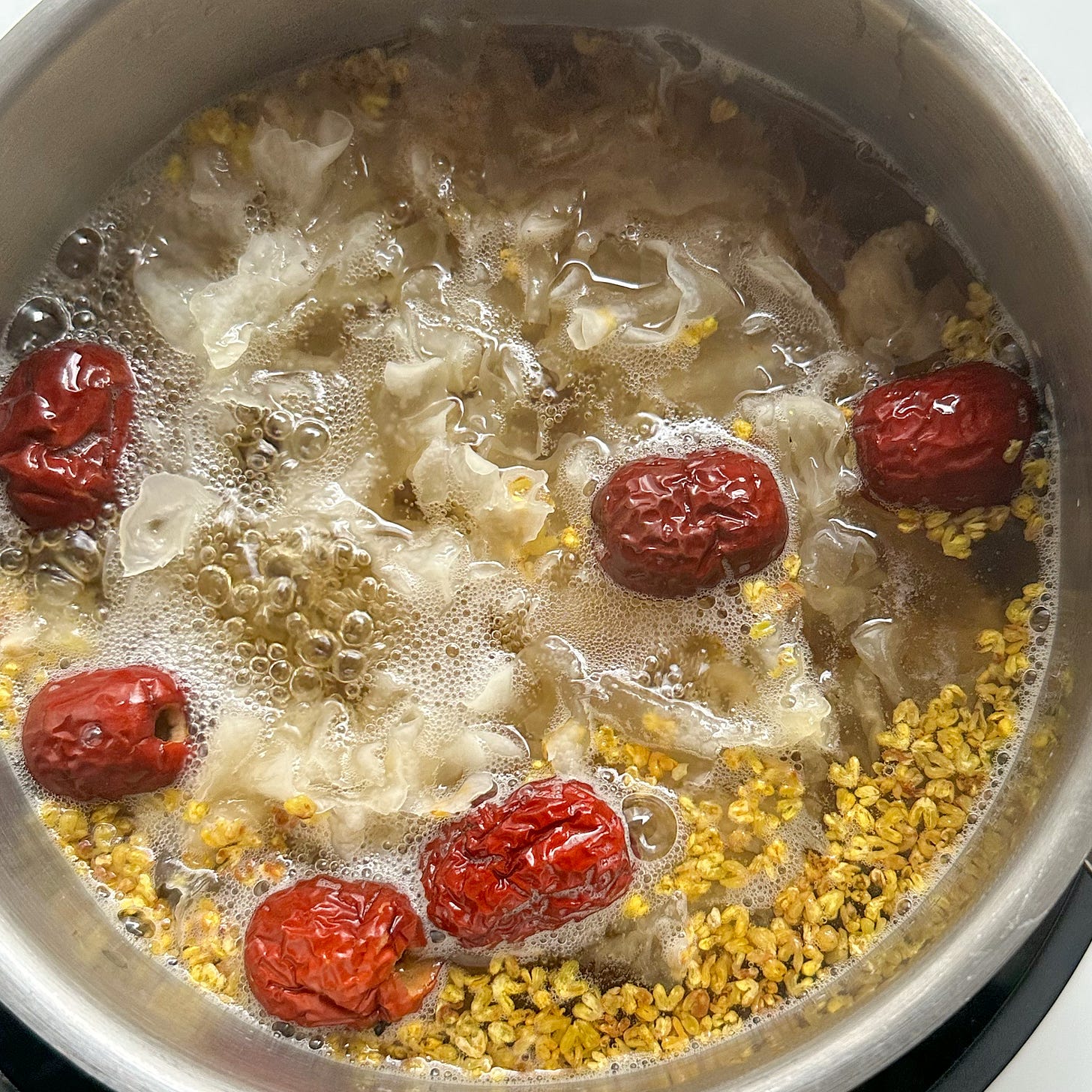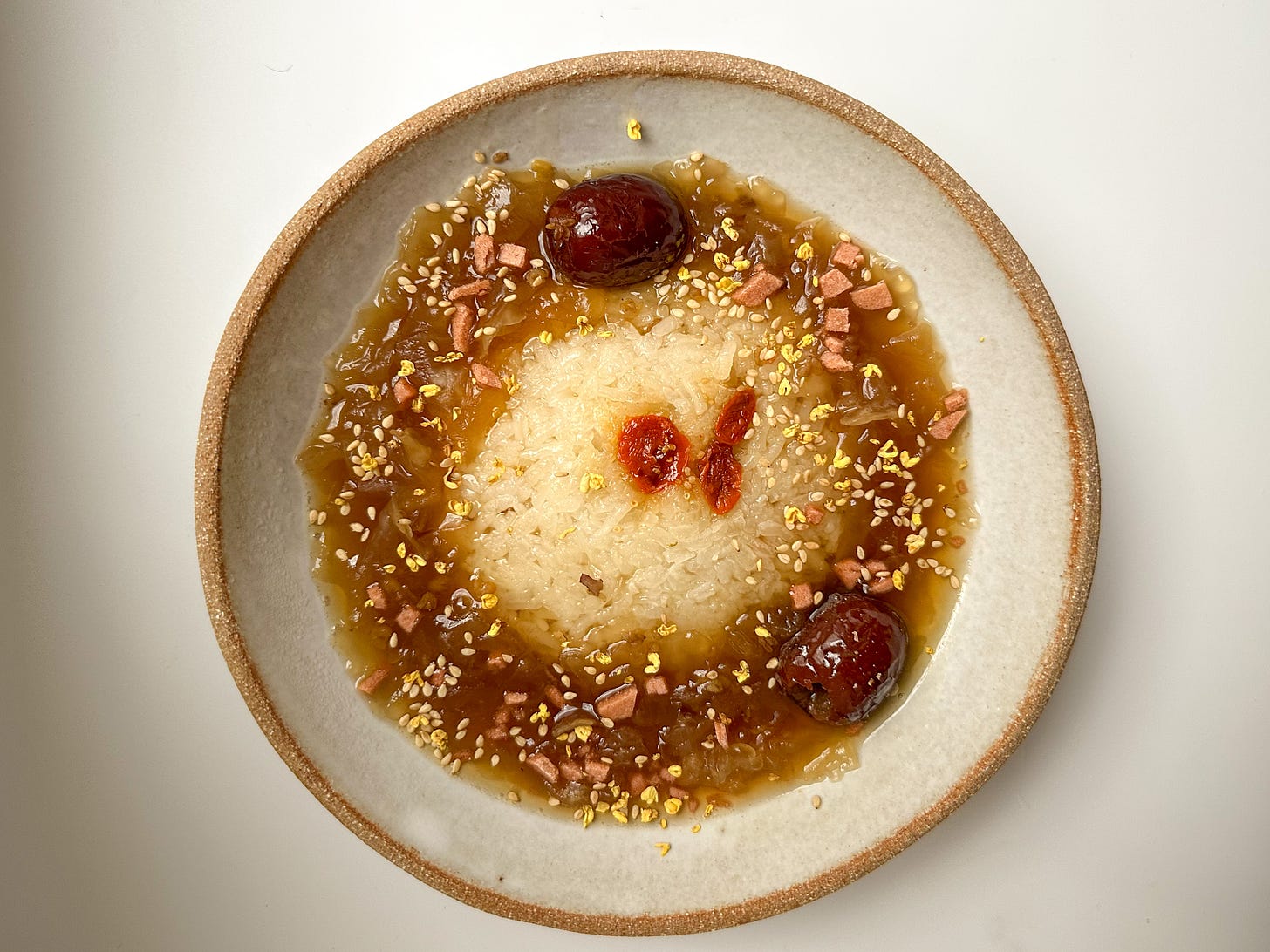Chinese New Year is approaching next Saturday! This year, I'll be sharing some traditional recipes that reflect my upbringing in Sichuan. The first one is a sweet dish (how rare for me!): steamed sticky rice in a dessert soup (糯米银耳汤).
I've recently come to realize the significance of sticky rice in traditional festival cuisine. During Chinese New Year, many families prepare Eight Treasured Rice (ba bao fan, 八宝饭): a sticky rice dessert made with lard, red bean paste, and a variety of dried and candied fruits. In my hometown Sichuan, a popular local version sometimes consists simply of steamed rice and sugar or topped with red bean paste and pork belly (tian shao bai, 甜烧白). More of the main sweet dish than dessert, this sounds confusing if you never had it before. But as a child, it was the sight of steaming hot rice accompanied that never failed to excite me, whenever I was brought to a New Year’s celebration lunch or a wedding banquet.
Sticky rice and Chinese New Year
Sticky rice, whether in its pure form or as an ingredient has long been associated with festivity for a reason. It's believed that ancient New Year celebrations originated from sacrificial ceremonies held at the end of the year to celebrate or pray for a good harvest. For a significant period, glutinous varieties were more prevalent than the non-glutinous rice commonly used today1. Thus wine and food made of sticky rice became part of sacrificial offerings and festival feasts. References to food made from sticky rice can be found in written records in the book The Rites of Zhou2 around the 2nd century BC.
With the climate change3, the agricultural division resulted in different New Year traditions: In northern China, where wheat cultivation became predominant, dumplings became a ritual, while south of the Yangtze River, celebrations revolved around various dishes made from glutinous rice. For example, sticky rice cake (nian gao, 年糕) is popular in the southeastern region near Shanghai. Another example is tang yuan, sticky rice balls filled with sesame or peanuts, often enjoyed on the last day of New Year celebrations during the Lantern Festival.
Food such as Zong Zi (steamed sticky rice wrapped in leaves) and Qing Tuan (a mugwort mochi dessert) are enjoyed during traditional festivals or Chinese seasonal events, deeply rooted in agricultural traditions. However, due to a decline4 in the consumption of sticky rice, many traditional foods are disappearing in the larger southern Chinese region. Nevertheless, sticky rice remains widely used in regions like Yunnan, Guangxi Province, and many Southeast Asian countries.
Snow fungus dessert soup
Inspired by a bowl of beautiful Eight Treasure Congee I had during my trip to southern Sichuan, where ancient Sichuan Shu culinary culture is more preserved: steamed sticky rice is served in hot snow fungus soup, topped with nuts and fruits.
Snow fungus soup (yin er tang, 银耳汤) is a popular dessert soup enjoyed across regions, especially on occasions like Chinese New Year. If you’ve had a cucumber with wood ear mushroom salad before, snow fungus (aka white fungus), is similar in appearance and texture but softer. This light yellow, almost translucent fungus comes in dry form, often used to make dessert soup, served warm or cold. It has been used in traditional Chinese medicine for its anti-inflammatory effects and is often paired with Asian pear to treat coughs and throat problems. Some believe it contributes to glowing skin, as in China, food with gelatine is linked to skin health.
After stewing, the snow fungus becomes very soft, imparting a gelatinous texture to the soup. I've learned the trick is to cook them in cold water and stir patiently. You can make this soup without sticky rice but with pear, coconut milk or even ripe papaya.
The recipe
servings: as dessert for 4
100g sticky rice
10g dried snow fungus (yin er)
1 L water
6 dried Chinese dates (jujubes)
15g dark brown sugar
25g rock sugar
1 tsp dried osmanthus
A handful of goji berries
Optionally serve with:
toasted sesame seeds
dried fruits like raisins or cranberries
unsalted roasted peanuts
Instructions:
Soak sticky rice overnight or for at least 4 hours until the kernels can be easily broken with your fingers. Soak dried snow fungus for 1 hour in warm (but not hot) water until rehydrated before cooking. Remove the stems and tear them into small pieces.
Over a pot of boiling water, set up a steamer with cloth, add drained, soaked sticky rice, and steam over medium-high heat for about 40 minutes. In the last few minutes, add dried goji berries.
Meanwhile, add snow fungus to a pot with cold water, bring to a boil, and cook over medium-high heat for 10 minutes. Then stir vigorously. Reduce heat to medium-low, stew for 15 minutes, stirring occasionally. Add dried dates, osmanthus, sugar, and stew for another 15 minutes until the soup thickens. If time permits, stew for longer.
When the sticky rice is cooked, add goji berries and let it rest for 10 minutes.
Add the sticky rice to a deep plate, ladle snow fungus soup over it, and scatter toppings of your choice. Serve as a dessert for your New Year feast or enjoy it for breakfast.
Watch me make it here!
Notes and substitutions:
Dried snow fungus is available in many asian grocery stores around the dried goods isle, for example from Go Asia in Berlin.
Rock sugar and dark brown sugar can be replaced with normal white sugar or light brown sugar, or even honey.
Dried osmanthus flowers are available at tea sellers here in Europe (here), which can be substituted with osmanthus syrup (here) available at Asian grocery store, or other dried edible flower such as rose petals, or other flower syrup.
I used both Thai sticky rice and Chinese short sticky rice; both work well. The important step is to soak them long enough and be patient.
I used a bamboo steaming basket plus cloth to steam the rice, but you can also use a fine sieve, optionally with cheesecloth or a nut milk cloth! If you cook them directly in water, it might get mushy.
From an interesting piece by agricultural researcher You Xiuling about the history of sticky rice in China. It's in Chinese, but I'll link it here.
Rites of Zhou《周礼》mentioned a fluffy cake made of sticky rice flour and water and a pounded sticky rice cake, reminiscent to today’s ci ba “糗饵粉糍“
You Xiuling believes that rice crops were also grown in the Yellow River region in the north, but as the climate became drier, the region opted for wheat cultivation.
Around the Qing Dynasty, the government promoted a movement to grow more non-glutinous rice (Japonica rice and Indica rice) than glutinous rice to increase yield due to population growth.

